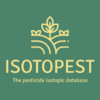Warning
Preliminary information
The ISOTOPEST database is a non-profit database available free of charge.
ISOTOPEST is an academic project and the authors/contributors declare no competing interests.
Back to Home Page
[Translate to English:] Database presentation
Database
- 2-(4-chlorophenoxy)-propionic acid
- 2-4-D
- Acetochlor
- Alachlor
- Aldrin
- AMPA (Metabolite of Glyphosate)
- Atrazine
- Azoxystrobin
- Bentazone
- Bromoxynil
- Butachlor
- Captan
- Carbendazim
- Chlordane
- Chlordecone
- Chloridazon
- Chlorpyrifos
- Clomazone
- Cyhalothrin
- Cymoxanil
- Cypermethrin
- Cyprodinil
- DDT Dichlorodiphenyltrichloroethane
- Deltamethrin
- Desethylatrazine
- Desisopropylatrazine
- Desphenylchloridazon
- Diazinon
- Dichlorprop
- Dichlorvos
- Dieldrin
- Difenoconazole
- Dimethenamid
- Dimethoate
- Dimethomorph
- Diuron
- Epoxiconazole
- Fenpropathrin
- Flufenoxuron
- Folpet
- Glyphosate
- Heptachlor
- Hexachlorocyclohexane
- Indoxacarb
- Isoproturon
- Isoxaben
- Kresoxim-methyl
- Malathion
- MCPA
- Mecoprop
- Metazachlor
- Methamidophos
- Methyldesphenylchloridazon
- Metolachlor
- Mirex
- Myclobutanil
- Omethoate
- Oryzalin
- p-p-Dichlorodiphenyldichloroethane
- Parathion-ethyl
- Parathion-methyl
- Pendimethalin
- Prochloraz
- Profenofos
- Propyzamide
- Pyraflufen-Ethyl
- Pyrimethanil
- Simazine
- Tebuconazole
- Terbuthylazine
- Terbutryn
- Tetraconazole
- Toxaphene
Technical aspects
Publications
How to contribute
Contact
Purpose of the ISOTOPEST database
Compound specific isotope analysis is a powerful approach to track the transformation of pesticides in the environement. By comparing isotopic signatures (C, N, H, Cl…) of remaining pesticide in water or soils to the applied formulations, this approach allows to estimate both degradation extent and pathways. However, the application of CSIA to pesticides remains limited because of the difficult isotopic characterisation of pesticide commercial formulations.
Several approaches have been then proposed to estimate the primary isotopic signature (PIS) of a contaminant in groundwater: i) based on literature research, ii) based on the most negative value at the site, or iii) based on point-to-point or time to time comparison (Hunkeler et al., 2008). With limitations, theses approaches are restrained to legacy compounds point source contamination in groundwater. For pesticides specific cases, diffuse sources do not allow direct measurements of applied formulations, except in few studies including surveys among farmers.
In addition to the difficulties to assess PIS of pesticides, the development and multiplication of isotopic systems (C, N, Cl, H, S...) and analytical methods (GC-IRMS, GC-MS, LC-MS, GC-MC-ICPMS…) increase the risk of drifted or inaccurate measurements. Developping intercomparison exercises for measuring isotopes in pesticides is important for several reasons: i) ensuring accuracy and consistency (across different methods and settings), ii) identifying sources of error (calibration errors, sample contamination, or methodological differences), iii) promoting collaboration and standardization and iv) building confidence in results. Such a step is important for expanding the use of pesticide CSIA to a larger scale beyond providing proof of concepts and to accurately help future decision-making.
In order to facilitate the use of CSIA approaches for pesticide tracking, it is essential to have a comprehensive isotopic database of pesticide formulations. Available online and open to contribution, our isotopic database, ISOPEST aims to i) archive and collect data on pesticide formulations for future studies, ii) develop analytical intercomparison exercises for pesticide CSIA, iii) open the CSIA approach to large scale studies for tracking pesticide transformation.
Database statistics Version of 10/05/2023
Applied formulations | Analytical standards | ||||||||
nformulations | nmolecule | nδ13C | nδ15N | nstandards | nmolecule | nδ13C | nδ15N | nmolecule total* | |
Fungicides | 40 | 15 | 40 | 19 | 19 | 13 | 19 | 5 | 21 |
Herbicides | 47 | 8 | 47 | 36 | 99 | 34 | 96 | 46 | 37 |
Insecticides | 21 | 6 | 21 | 0 | 226 | 41 | 198 | 15 | 43 |
SubTotal | 108 | 29 | 108 | 55 | 344 | 88 | 313 | 66 |
|
Total** | 452 | 101 | 421 | 121 |
| ||||
* nmolecule total corresponds to the number of different molecule available in the database by categories (fungicides, herbicides, insecticides) ** Total entries correspond to the sum of applied formulations and analytical standards entries
How to read the database
The database is sorted by active molecules.
A first table reference the isotopic compositions of pesticide analytical standards and commercial formulations:
| Manufacturer | Applied/standard | Isomer ? | Isomer enriched | Batch/Lot n° | Commercial Name/Formulation | Purity (‰) | δ13C (‰) | ± (‰) | δ37Cl (‰) | ± (‰) | δ15N (‰) | ± (‰) | δ2H (‰) | ± (‰) | Measurement method | Reference: DOI Number | Reference Citation |
|---|
A second table reference some bio-physico-chemical informations:
| Pesticide class | Pesticide Type | Chemical formula | #C | #Cl | #N | #H | #O | Other Elements | Molar mass (g/mol) | %C | %Cl | %N | %H | %O | %Others | Water solubility at 20°C (mg/l) | Melting point (°C) | Boiling point (°C) | log Kow | Soil DT 50 lab (days) | Soil DT50 field (days) | Koc (L/kg) |
|---|
The different columns are filled according to available informations.
Unless specified, the bio-physico-chemical informations were recovered from the PPDB - Pesticide Properties DataBase, fully available at :
http://sitem.herts.ac.uk/aeru/ppdb/en/index.htm
Despite the carreful attention paid to the website maintenance, please inform the webmasters at "contact" if you notice a mistake in the database.

